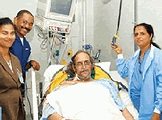 美國德州休士頓醫學中心在艾克(Ike)颶風蹣跚掠過後,院區一度積水深達數英吋,景象彷彿回到2001年艾里森(Allison)颶風來襲時帶來的洪災。
美國德州休士頓醫學中心在艾克(Ike)颶風蹣跚掠過後,院區一度積水深達數英吋,景象彷彿回到2001年艾里森(Allison)颶風來襲時帶來的洪災。
幸在院方與萊斯大學(Rice University)長期合作下開發洪水警報系統,大幅降低熱帶性暴風釀災引起的恐荒。此警報系統能精確地預測醫學中心內積水的程度,使得不論艾克在外頭挾帶何等狂風暴雨,醫療團隊依然可以成功為一位老兵進行救命手術。
儘管颶風一度在關鍵時刻中斷萊大計算機中心的電力,校內研究人員仍可準確預測颶風期間與過後,休士頓Brays支流水位的至高點。
萊大工程學教授貝迪恩特(Phil Bedient)早自艾里森颶風過後,便與德州醫學中心合作設置即時洪水警報系統,而這次艾克過境,讓他可以透過系統掌握水位變化的動態。
即使自己在休士頓的家陷入停電,貝迪恩特仍長夜堅守崗位,透過電話取得美國國家氣象局雷達偵測的降雨資料,並通報醫學中心人員預期的洪水量。
他指出,「Brays的水位距離潰堤只差2英呎」。「Brays支流測得流量每秒25,500立方英呎,相當接近我們預估的每秒26,800立方英呎;此外,洪水發生時間和我們的預測幾乎同時」。而流經醫學中心南方的支流以每秒29,000立方英呎的流量,形成一條巨大洪流。
當德州灣岸居民在艾克颶風接觸前的12小時,補強門窗與購買電池時,德州醫學中心正在為一位59歲的病患進行一項腎臟移稙手術。
Michael E. DeBakey VA醫學中心內科醫師柏格(David Berger)表示,「我們無法因為這點滴風雨,就放棄一位退休老兵的求生希望」。
艾克颶風在9月27日清晨2點於德州蓋維斯頓附近登陸。不到幾小時的時間,休士頓陷入一片漆黑、道路積水、樹木與電線被攔腰折斷、大雨直落、狂風呼嘯,痛擊整座城市;然而,貝勒醫學大學(Baylor College of Medicine)腹腔移植主治醫師高斯(John Goss)仍冒著風雨,前來醫學中心探望病患,並為這名老兵的腎臟移植手術付出己力。
貝迪恩特與「強烈暴風預測暨宣導與疏散災難中心」(Severe Storm Prediction, Education and Evacuation from Disaster Center, SSPEED)內的夥伴們正致力將德州醫學中心所採用的預警系統,推廣至整個大休士頓地區。
SSPEED是由德州灣岸多所大學、緊急應變管理人與公私部門社團所組成的組織,假以處理暴風預測、災害計劃與規劃民眾從紐奧良疏散至布朗斯維爾等問題。最主要的目的是希望在還有時間搶救生命與財產前,透過洪水預警機制提供當局相關資料,盼能在洪水淹沒路面、沖毀橋樑前,快速做出應變措施。
The Texas Medical Center in Houston came within inches of being flooded during and after Hurricane Ike, but a long-term collaboration with Rice University calmed fears of the kind of deluge that caused extensive damage during Tropical Storm Allison in 2001. An accurate prediction of flood levels at the medical campus allowed a war veteran to have a life-saving operation amidst Ike's torrential rain and howling winds.
Rice researchers precisely predicted the peak surge of Houston's Brays Bayou during and immediately after Ike, despite power outages that shut down the university's computing center at a critical time.
Phil Bedient, , a professor of engineering at Rice, who with the Texas Medical Center has set up a real-time flood alert system in the years since Allison, saw that effort pay off during the storm.
Having lost power at his own Houston home, Bedient spent a long night during Ike evaluating radar rainfall data coming by phone from the National Weather Service's radar and calling medical center officials with his predictions.
"Brays was two feet from going over its banks," he said. "The measured water flow in the bayou was 25,500 cubic feet per second. We had predicted 26,800, and we predicted it to occur at almost exactly the same time." The bayou, which runs just to the south of the medical center, floods at 29,000 cubic feet per second, he said.
As it happened, while Texas Gulf Coast residents were boarding up windows and buying batteries less than 12 hours ahead of Hurricane Ike, doctors at the Texas Medical Center were performing a liver transplant on a 59-year-old man.
"We could not deny a veteran the chance for a potential life-saving procedure because of a little wind and rain," said David Berger, M.D, a physician at the Michael E. DeBakey VA Medical Center.
Hurricane Ike made landfall at nearby Galveston, Texas at two o'clock on Saturday morning. A few hours later, with power outages across Houston, flooded streets, downed trees and power lines, and rain bands and wind gusts still battering the city, John Goss, M.D., chief of abdominal transplantation at Baylor College of Medicine, which partners with the Veterans Administration in liver transplant efforts, made his way to the hospital to check on his patient.
Now, Bedient and his colleagues at the Severe Storm Prediction, Education and Evacuation from Disaster Center, or SSPEED, are working to extend the same predictive capabilities they used for the Texas Medical Center to all of Greater Houston.
SSPEED is an organization of Gulf Coast universities, emergency managers and public and private partners formed to address deficiencies in storm prediction, disaster planning and evacuations from New Orleans to Brownsville. The goal is to provide authorities with information from a new flood prediction tool while there is still time to save lives and property. If a road is likely to go under or a bridge may be washed over, officials will get the word quickly.
全文及圖片詳見:ENS


